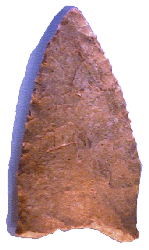

Point Type: DALTON
- GREENBRIER
Also See: Alamance, Breckenridge, Dalton, Dalton-Hemphill, Golondrina, Greenbrier, Hardaway, Harpeth
River, Haw River, Meserve,
Pelican, Plainview
Location: Midwestern to Eastern United States and Florida
Associated Dates:
10,000-6000 B.P.- Late-Transitional Paleo to Mid-Archaic
Morphology: Auriculate
General Description: The Dalton-Greenbrier dart point is a medium to large sized auriculate type with a concave base and drooping to expanding ears or auricles. Many specimens show some form of serrations on the blade edges. Some specimens have flutes on both sides. The hafting area has incurvate, heavily ground side edges and basal grinding. Resharpened examples will often have a bevel on the right side of each face. Thinness and a high quality of flaking technique is present on many examples.
The size of Dalton-Greenbrier points can range from 40 mm to 68 mm in length. The point was named by Madeline Kneberg for examples which were recovered from sites in the Greenbrier area of Kentucky Lake in Tennessee.
About The Point Above: The point pictured at the top of this page, was found in northern Arkansas. It is a poor example of the type and it represents a totally exhausted blade that was probably discarded or lost after many resharpenings. One of the auricles or ears has been chipped off and is missing. The missing ear was then retouched and regound by the pre-historic user. The blade has uniface bevels (right side) that show very moderate serrations. Microscopic examination shows that he edges of the blade have been crushed suggesting use as a blade or knife before loss or discard. The point is made from light tan colored flint that has some white inclusions. It has a basal thinning scar or flute on one side. The flute on the photographed side is 19 mm in length. Overall, the point measures 54 mm in length, is 28 mm wide (across the ears or auricles) and is only 8 mm thick in mid blade. The concavity of the base is 3 mm deep. The base is ground as are the ears and blade edges running 18 mm up from the long ear of the base. Close microscopic examination reveals rounding/polishing on most of the high ridges of the knapping scars, probably due to the natural effects of either erosion, abrasion, or weathering after discard or loss. Catalog Number 21-40-C
References: Baker, Justice, Overstreet, Waldorf
© Copyright 1997 - 2008 LITHICS-Net WWW.LITHICSNET.COM
Use Your Browser's BACK Button to Return to the LITHICS-Net Index.